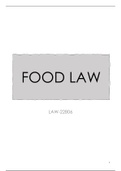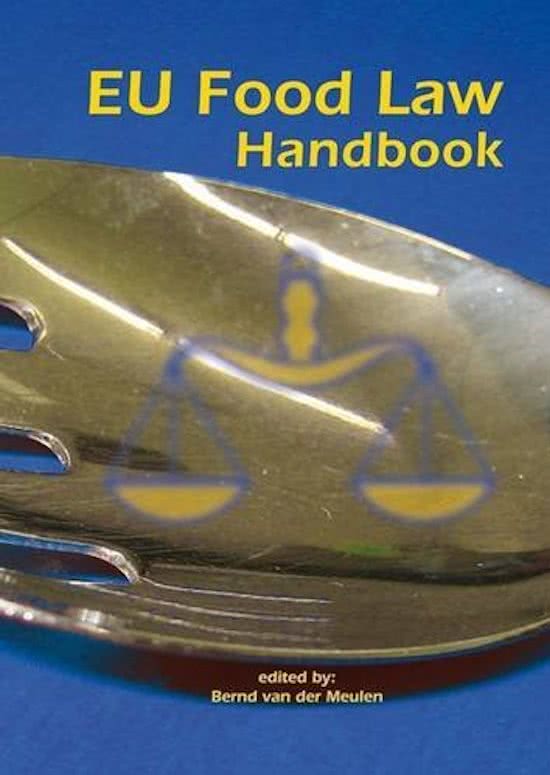FOOD LAW
LAW-22806
1
, LECTURE 2. Introduction to EU substantive law
Food Law approached through a trade perspective
European Union
Free trade between members Article 30 TFEU
Common external tariffs Article 31 TFEU (The Customs Union)
The Free Movement of Goods
Prohibition of Quantitative Restrictions
Factor mobility across borders
Between Member States.
Articles 34 & 35 TFEU
Ban on quantitative restrictions on imports and measures of equivalent effect
The restrictions banned would be for example Germany banning the import of one ton
of a good from France.
Example: Italy wants Italians to buy their own wine, but with the prohibition of
quantitative restriction they cannot put taxes to French wine to enter the Italian market.
Which solutions are proposed?
a) Decrease the taxes of the Italian wine (in this case it wouldn’t be a quantitative
restriction, but it would be a measure of equivalent effect.
b) Another solution would be to put the label Protected Designation of Origin
(PDO) to the Italian wine, but in this case it would also be a measure of equivalent
effect. (Parma cheese (PDO) can only come from Parma).
Dassonville and Cassis de Dijon were decisive cases in the Food Law (see annex).
Structure of Fundamental Freedoms
1. Pre-test
o No Secondary Legislation
o Cross-Border Transaction
2. Scope
3. Infringement
4. Justification
Phases of food law
• 1st phase: product standards
o Vertical harmonisation
o “Independent” directives/regulations, like for mineral waters, honey,
marmalades…
• 2nd phase: horizontal approach
o Horizontal harmonisation
• 3 phase: Food Safety
rd
The Food Safety approach was initiated by the White paper.
How to define a standard that works in all Member States which also complies with the
European law? With the help of science, which is carried out by EFSA.
2
, SCHEME
White Paper on the White Paper on
Internal Market Food Safety
(1985) (2000)
Product standards 80s&90s Horizontal 2000: Food Safety
(vertical approach) approach approach
1979: Cassis de Food Crises
Dijon (mutual
recognition) 1987 Single European Act:
Creation of Internal Market
Where does the European Food Law in terms of Food safety come from?
• 1997 Medina Ortega report
• 1997 Green paper
• 2000 White paper
• Legislation à 2002 General Food Law
• 84 Legislative initiatives (GMO’s, Food and feed safety controls, Hygiene/HACCP,
allergen labelling, nutrition and health claims, policy on nutrition and obesity,
additives, flavourings, enzymes, novel foods, food information, etc.)
LECTURE 3. Intro to tutorials and database training
Legal Acts:
• Regulation: it shall have a general application. It shall be binding in its entirety and
directly applicable in all Member States.
• Directive: it shall be binding upon each Member State to which it is addressed but
shall leave to the national authorities the choice of form and methods.
• Decision: it shall be binding in its entirety. A decision which specifies those to whom
it is addressed shall be binding only on them.
• Recommendations and opinions: they shall not be binding.
• Green papers (policy document): documents published by the European
Commission to stimulate discussion on given topics at European level. Green
Papers may give rise to legislative developments that are then outlined in White
Papers.
• White Papers (policy document): documents containing proposals for Community
action in a specific area. In some cases, they follow a Green Paper published as
a consultation process at European level. Never refer to these policy documents
to solve a case, because they are very general.
• Guidelines: explain how a specific legislation is understood by the Commission
and to help stakeholders to deal with it. Never refer to guidelines when solving a
Case.
3
, The difference between a regulation and a directive is that the first is binding in its
entirety, while the second one need to be implemented in each MS law.
What does that mean? If you go to court in Germany and there is a EU regulation, the
German judge is going to use the UE regulation to apply to your case. If you have a
directive, there’s only duty on the MS who adopt their own legislation in line with the
directive. Then, if you go to the court, you will be applied the German law which is in line
with the EU regulation. Furthermore, the Regulation does not tell MS a specific limit, but
a range of possible limits, so each MS can choose where to put the limit. The Directives
can be both ways: they can give to the MS margin to adopt the measures or not.
EXAM!:
Regulation Directive Decision
Addressed to MSs or
General application General application
individuals
MSs transpose them into
Directly applicable Directly applicable
national laws
Binding à That cannot be legally avoided or stopped (especially of an agreement).
An Annex has the same value as an Article, so they are at the same level in the
legislation. The Annex has more technical information and is easier to change than the
Articles, while the Articles have more general rules.
1. Primary legislation: Treaties (very difficult to change): Establish the distribution of
competences between the EU and the Member States. Describe the powers of the
European Institutions.
2. Secondary legislation: regulations, directives (easier to change): Article 288 TFEU. It
includes decisions, opinions and recommendations, but also “atypical” acts like
communications, white and green papers.
3. Tertiary legislation: case law (Court of Justice of the EU)
EXAM —> we need to know the differences between all those
The regulation comes directly from the EU, but the directives are the base of the national
laws, and so, they are applied inside the law of the member state.
ILAC Method
Issue: What is the legal problem? Identify the legal issues to be resolved.
Law: Which law is applicable? How do I interpret it? Interpret status and other rules.
Application: Connect the facts with the law. Provide reasons why the rules do or do not
apply to the facts.
Conclusion: by answering the legal issues.
Example:
Supermarkets in France sell food “biologique”, in the UK they are “organic”, in Spain “organic”
and “bio”. Are these products the same?
Issue: Is there any difference between “bio” and “organic” foods according to the law?
4





